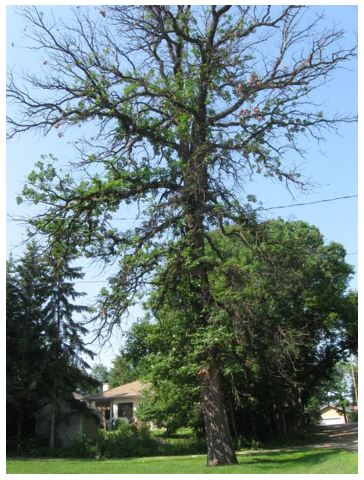About Oak Decline
In Winnipeg, the oak decline is a disease of bur oak. Visible symptoms include dieback of leaves and the major limbs at the topmost part of the tree's canopy. Contrary to popular belief, two-lined chestnut borer does not cause oak decline. The insect is a secondary stress factor, and it attacks trees that are already in decline or under stress. You can help prevent oak decline (and the subsequent infestation of the two-lined chestnut borer) by protecting your oak trees against stress factors, such as drought, flooding, and root damage due to construction activity. Practices that reduce stress to your oak tree and prevent attracting two-lined chestnut borer include:
- Weekly or bi-weekly (depending on rainfall) thorough watering around the tree’s dripline or deep root watering during long periods of drought.
- Applying a thin layer of mulch on the soil’s surface around the tree to conserve soil water and slowly release nutrients.
- Removal of sediments moved over the roots by flood waters.
- Installation of drainage tiles to lead water away from oaks in constantly waterlogged soils.
- Vertical mulching to aerate soils.
- Installation of a Tree Protection Zone enclosing an area to the extent of the drip line, in the least, to avoid soil compaction over the roots during construction activities.
- Application of a thick layer (around 30 cm) of mulch temporarily in areas where a Tree Protection Zone cannot be set up during construction activities to disperse pressure of heavy machinery and people moving over the soil.
- Sanitation, the removal and burning or burial of dead oak trees and branches, to prevent two-lined chestnut borer beetles from using the material for broods.


